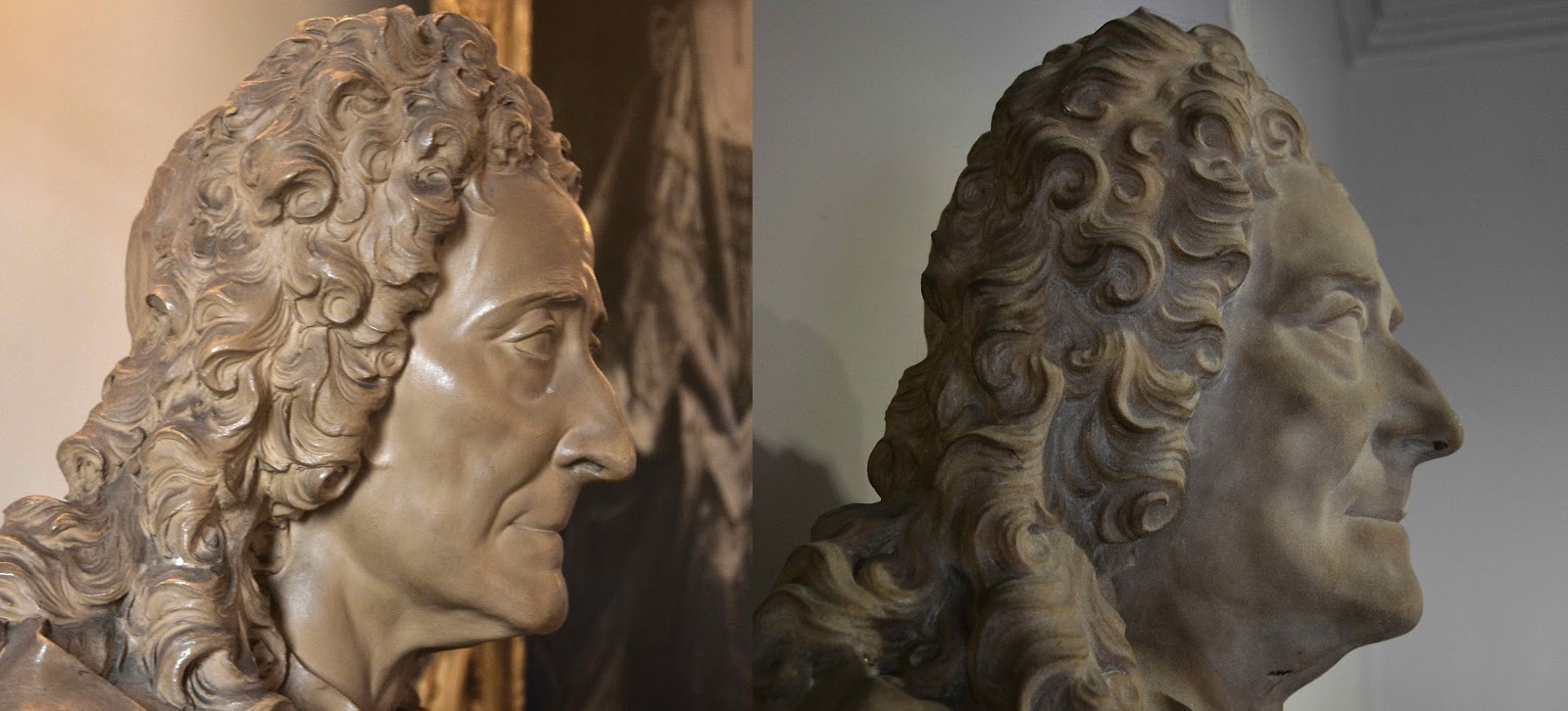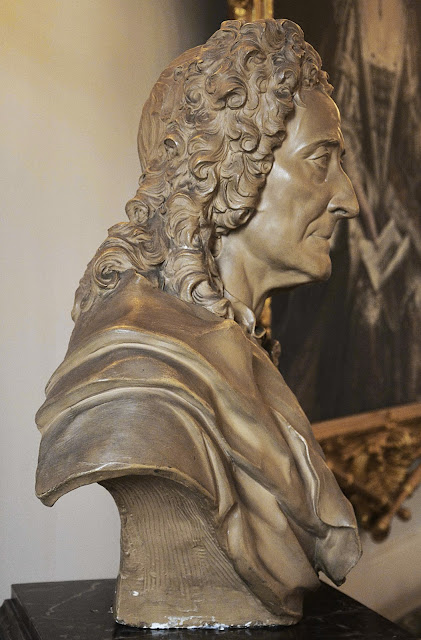Richard Miller. (c.1652 - 1724).
The Marble and Terracotta Busts.
by Michael Rysbrack (1694 - 1770).
The terracotta bust signed and dated MICHL. RYSBRACK. 1726/7.
at Queens College, Oxford.
The subject of this bust is something of a mystery - the extracts provided below tell us as much as we know.
He is recorded in the Album Benefactorum of Queen's College, Oxford in 1716 - 17 as donating £100 towards the building of the Chapel.
He was also a great benefactor to the Parish of St Martin's in the Field Westminster providing £500 for the Charity Schools, £300 for the Free School and Library and £300 for the building of the Vestry House.
In his very short Will (Prob 11 / 600) written 4th October 1718, Richard Miller of South Hinksey, left to his daughter Mary, his tenanted house in St Thomas Parish, Oxford he also bequeaths her all his goods and chattels - to his other daughter and son Matthew he left one shilling!
_____________________________________
I am very grateful to Graeme Salmon of Queens College, Oxford for permission to photograph this bust and for his enthusiastic welcome and assistance when visiting Queen's College.
The subject of this bust is something of a mystery - the extracts provided below tell us as much as we know.
He is recorded in the Album Benefactorum of Queen's College, Oxford in 1716 - 17 as donating £100 towards the building of the Chapel.
He was also a great benefactor to the Parish of St Martin's in the Field Westminster providing £500 for the Charity Schools, £300 for the Free School and Library and £300 for the building of the Vestry House.
In his very short Will (Prob 11 / 600) written 4th October 1718, Richard Miller of South Hinksey, left to his daughter Mary, his tenanted house in St Thomas Parish, Oxford he also bequeaths her all his goods and chattels - to his other daughter and son Matthew he left one shilling!
_____________________________________
I am very grateful to Graeme Salmon of Queens College, Oxford for permission to photograph this bust and for his enthusiastic welcome and assistance when visiting Queen's College.
The marble bust is in the Vestry of St Martin's in the Fields, Westminster.
I am also very grateful to Helena Tarrant, Church Coordinator at St Martin's in the Fields for obtaining permission to photograph the marble and for all her assistance, particularly for finding a ladder so that the bust could be inspected at close quarters.
Also thanks are again due to Dana Josephson for suggesting and aiding me with this project.
______________________________
I am also very grateful to Helena Tarrant, Church Coordinator at St Martin's in the Fields for obtaining permission to photograph the marble and for all her assistance, particularly for finding a ladder so that the bust could be inspected at close quarters.
Also thanks are again due to Dana Josephson for suggesting and aiding me with this project.
______________________________
There are brief notes and photographs of the two busts in Michael Rysbrack, Sculptor by M.I. Webb pub. Country Life, 1954.
The terracotta bust at Queen's was formerly mistaken for a bust of Sir Christopher Wren and prior to that to as a bust of Voltaire.
The relationship between these two busts was first noted in an article by Katherine Esdaile in The Architectural Review of 1944.
The terracotta is possibly the bust mentioned by the engraver and diarist George Vertue (1684 - 1756) in 1732 as Muller. - see Vertue III, 56 - Walpole Soc. Journal.
_______________________________
The Terracotta Bust and Marble Busts of Richard Miller
Queens College, Oxford.
Queens College, Oxford.
_____________________________________
Extract from The Gentleman's Magazine Vol 60 part I, 1790.
_________________________________________
Extract below from Catalogue of Portraits in the Possession of the University, Colleges, City and County of Oxford. Mrs Reginald Lane Poole, Vol II, pub Clarendon Press, Oxford. 1925. refering to the terracotta bust at Queen's College, Oxford.
https://archive.org/details/b22652061_0002

The Queens College bust of Miller in the Library
Photography by Henry Taunt, 1906.
Photograph from Historic England Archive
_____________________________________
The Marble Bust of Richard Miller by Michael Rysbrack
Currently located above the front door, in the vestibule
of the Vestry of St Martin's in the Fields, Westminster.
All photographs here taken by the author.
Something of a challenge to photograph this bust - very little light.
Fortunately Helena Tarrant of St Martin's was able to commandeer a set of step ladders.
________________________________

Richard Miller
Oil on Canvas
123.3 x 100 cms
1723
Queen's College, Oxford.
Given by the Sitter.
Inscribed "RICHARDUS MILLER GENEROSUS COLL. REG. D.D. TENEMENTUM. ETC. ET EX OCCIDENTALI PARTE HOSPE: IN USUM PRAEPOSITI A.D. 1723
Richard Miller lived at South Hinksey, Oxford and gave £100 towards
the Queen's College building programme.
The inscription on the back of the canvas,
which has been relined probably in the nineteenth century, may be a copy of
some original inscription erroneously transcribed as 'T. Weurzag Se' and which
Poole interprets as standing for 'T Murray Fecit'.
The attribution to Murray has
been challenged.
Image and info here from Art U.K.
_____________________________________________

Mrs or Mary Miller.
daughter of Richard Miller.
attributed to Jonathan Richardson (c. 1665 - 1745).
Oil on Canvas.
125.5 x 101cms.
before 1724.
Queen's College, Oxford.
Given to the College by Richard Miller.
Image from Art U.K.
_______________________________________
View of the West Front of the Parish Church of St Martin's in the Fields, Westminster before demolition and replacement.
Engraving
George Vertue
1720.
The Vestry House is on the left hand side, on the North side of St Martin's Place.
Image Courtesy British Museum
____________________________________
St Martin's in the Fields.
Westminster.
View of the South and West Fronts.
1754
Image - British Museum.
The Vestry House to the lefdt is on the North side of St Martin's Place.
The earliest record of a parish school at St. Martin's is an
entry in the churchwardens' accounts for 1571: "payd to geyls quarrell for
setinge the scolhowse wyndowe & for vj newe q'rels iijs ijd." Ben
Jonson received his early education at this school, which was probably situated
beside the church. In 1614–15 a new schoolhouse and vestry room was built adjoining
the church on the south side. This building is shown in Vertue's drawing of the
old church .
The Vestry met in the upper room, the school being
housed on the ground floor until 1693, when the scholars were transferred to
Archbishop Tenison's school (see p. 113). The old schoolroom was used as a
session house from 1706 until the church was pulled down. A new vestry hall was
built at the south-east corner of the churchyard in 1728, and demolished in
1828. 113–4).
The buildings in St. Martin's Place which comprise the
Vestry Hall, Vicarage, and National Schools were erected circa 1830 as part of
the Charing Cross improvement scheme. The façade of the schools bears the
inscription "St. Martin's National Schools. Built by Subscription on
Ground the Gift of His Majesty King George IV. MDCCCXXX." (fn. n1) By the
deed of grant, dated 20th July, 1833, the Crown conveyed to the Vicar and
Churchwardens a piece of ground on the north side of the churchyard 98 feet by
28 feet together with the school building lately erected there to be used as a
National School for the education of poor children of the parish. A nominal
rent of £1 per annum was to be paid.
St Martin's in the Field was designed by James Gibbs.
The foundation stone of the church was laid on 19th March 1722 and the church was completed in December 1724.
St Martin's in the Field was designed by James Gibbs.
The foundation stone of the church was laid on 19th March 1722 and the church was completed in December 1724.
St Martin's in the Field from the West with the King's Mews in the foreground
This was replaced by the National Gallery in 1834.
It is my intention to treat St Martin's Lane, the epicentre of the London Art world in the mid 18th century, much more thoroughly in the future.
_________________________________

Michael Rysbrack.
attributed to the circle? of Jonathan Richardson.
c. 1730.
c. 1730.
Oil on Canvas 74 x 64.1 cms.
Victoria and Albert Museum
Image from Art U.K.
___________________________________________________























No comments:
Post a Comment